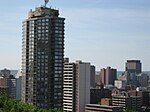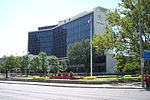St. Joseph's Healthcare Hamilton

St. Joseph's Healthcare Hamilton is a 777-bed academic health science centre in Hamilton, Ontario, Canada that is affiliated with the Michael G. DeGroote School of Medicine of McMaster University as well as Mohawk College. It is part of the St. Joseph's Health System and serves as the regional kidney transplant centre for a population of approximately 1.2 million people. With three locations in Hamilton, the hospital is known for being one of the top national institutions for robotic surgery and for having one of the largest kidney and urinary programs. It's also first in Canada to partner a mental health worker with police to respond to a 911 crisis call.Other services include acute care, surgical and outpatient services at three locations.
Excerpt from the Wikipedia article St. Joseph's Healthcare Hamilton (License: CC BY-SA 3.0, Authors, Images).St. Joseph's Healthcare Hamilton
Charlton Avenue East, Hamilton
Geographical coordinates (GPS) Address Nearby Places Show on map
Geographical coordinates (GPS)
| Latitude | Longitude |
|---|---|
| N 43.24894 ° | E -79.87151 ° |
Address
Juravinski Innovation Tower
Charlton Avenue East
L8N 1Y2 Hamilton
Ontario, Canada
Open on Google Maps









